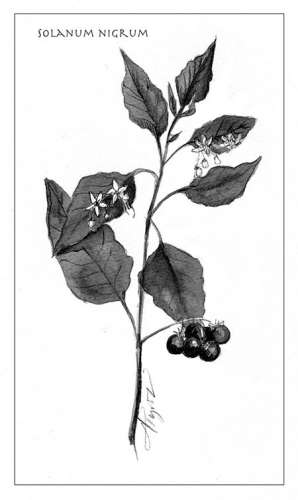
“I’ve got a botanical question for you,” my friend said as he came into my classroom the other day. “Is black nightshade edible?” He’d found some growing near his chicken coop. “I took the tiniest bite,” he said. “I’m not sure if I felt funny because of what I ate, or because I was nervous.”
I told him that black nightshade is edible, if what he had was actually black nightshade (note: there is also an unrelated plant called deadly nightshade, which is toxic). I asked him to describe the plant, and after some discussion, he asked if I had ever eaten it. I never had. “Why not?” he asked, and I had to pause. At least partly, I haven’t eaten it because of fear.
It’s no secret that people are nervous about eating wild foods. Once, while I was gathering wild blueberries, perhaps the most recognizable of wild fruits, a passing hiker admonished her teenage companion not to touch them. When the kid pointed out that I was eating them by the handful, she said, “well, he must know what he’s doing.”
Like this hiker, some people don’t trust their ability to identify even the most common wild plants. But that mistrust is irrational. Very few wild plants are deadly poisonous, and identifying plants is a skill that comes naturally to humans. It wasn’t long ago that all people made their living gathering wild food. With only the most cursory guidance, my three-year-old can identify dozens of species.
So why was I afraid of eating black nightshade? The main reason was that black nightshade wasn’t a plant I knew well.
On one plant walk I gave several years ago, I pointed out a plant that belonged to the carrot family, a group that contains the deadliest plants in North America. One woman heard the word carrot, assumed it was safe, and tasted it. Fortunately, she was fine. But she had put herself at tremendous risk.
There is no way around it: to gather wild plants, you must know wild plants. This doesn’t mean you need to memorize the thousands of plants that grow in your region. But it does mean that you need to know the most poisonous ones. You should know the plants that look similar to the ones you are foraging. And every plant that you eat should be identified with several trustworthy field guides, or better yet, a trusted expert. The day after our conversation, my friend left a sample plant on my desk, its roots wrapped in foil. I sat down with three of my field guides and keyed out the plant until I had no doubt about what I was holding in my hand, Solanum nigrum, the black nightshade. I still didn’t eat it, though.
I’ve only ever gotten sick from wild foods once. I’d gathered day lily blossoms and stuffed them with cheese and fried them. I was certain of my identification. I knew day lilies were edible. I’d eaten other day lilies before. These tasted delicious. But they also made me sick. It was a hard way to learn that an uncommon strain of these flowers causes nausea and diarrhea.
If the first great law of foraging is to know what you’re eating, the second is to start slowly with any new wild food. First, taste without eating. Wait a few hours. Next, take a bite. Wait a few hours. Then, eat a small portion. Wait. If something tastes unpleasant, stop. Such caution could have saved me from an unpleasant afternoon had I followed it with my new-found patch of day lilies. Indeed, a good first taste protocol did save me when, early in my foraging career, I misidentified the early spring shoots of a poisonous plant called dogbane. A single taste was all it took to realize my mistake. Some would ask why bother with all of this. The grocery stores and farmer’s markets are full of good food: food that doesn’t require field guides, food that doesn’t need to be meticulously tasted, food that feels safe. Perhaps they are right. But there is a kind of nourishment that I get from wild foods that I can’t buy in a market. When I finally know a wild food well enough to eat it confidently, there’s a connection: to the plant, to my ancestors, and to this green earth.
At my desk I roll one of the black nightshade berries between my fingers. I break its dark skin and touch the berry to my tongue.

